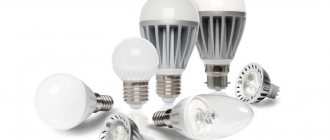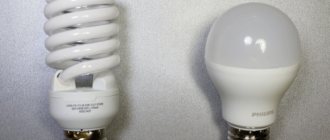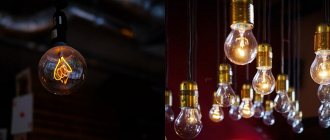How lighting affects vision and mood
Cold light tones, warm light soothes.
As for the effect on the human central nervous system, different shades of lamps (cold, neutral, warm) work like this:
- Cold - invigorates, tones, increases concentration.
- Neutral - almost equal to daylight, therefore does not have a significant effect on the central nervous system.
- Warm - relaxes, creates a feeling of peace, comfort, softness.
Not a single shade of the lamp has a negative effect on the eyes. The exception is flickering light. It provokes increased tension in the visual organs when a person is at rest and when performing work that requires increased concentration: reading, watching TV, manicure, sewing, etc.
Additionally, shades of light can change the colors of surrounding objects - making them more muted or, on the contrary, brighter. Incandescent light can enhance all warm colors. Cold lighting also works in relation to related shades. Therefore, it is advisable to choose interior items and furniture for the house at the level of lighting that prevails in the desired room. Otherwise, unpleasant surprises are possible when arranging what you purchased.
With age, the lens of a person's eye turns slightly yellow. Therefore, all tones and lighting are seen in warmer variations. To correct this perception, you can add a cold lamp to the room.
Rules for the use and organization of lighting
Cold and warm lighting affect not only the perception of colors, but also a person’s well-being. Below we consider the features of the impact:
- warm tones soothe in the evening, gently awaken in the morning: they produce a soft, non-oppressive effect, create comfort;
- a neutral shade of light imitates daylight, promotes stimulation of the central nervous system and brain activity;
- Blue light bulbs are most similar to the glow of the moon, so if used incorrectly they can cause depression and apathy.
Based on the effect on mood and surrounding objects, we draw conclusions on the use of lighting devices:
- Warm light in the interior is necessary to create a cozy atmosphere: suitable as additional lighting for relaxation in the living room, pendants over the dining table, sconce or floor lamp in the reading corner, lighting in the bedroom, children's room in the evenings before bed.
- Cold light in the room is invigorating only in small quantities, so a table lamp on the desk or lighting in the shower in the morning is enough to concentrate. It is not recommended to use fluorescent lamps with blue undertones as the main scenario in any room.
- Neutral lighting devices are called natural for a reason: they most accurately imitate the usual daylight, which is why experts recommend white lamps for most people as the main sources.
The last nuance in choosing the temperature is a design one. Some light shades are literally associated with a particular interior style, and therefore deserve special attention.
- All vintage, palace, classic and retro styles gravitate towards temperatures up to 4500K (warm light). The main reason is the visual resemblance to the fire of a candle or kerosene stove, which were used at the birth of these trends.
- Cold light is appropriate in ultra-modern interiors: minimalism, hi-tech. In combination with glossy surfaces, an abundance of glass and metal, LEDs set the right mood. Cold bluish lighting in the apartment creates a slightly hospital atmosphere, so you shouldn’t overdo it.
But going to extremes is not always right. Taking into account the peculiarities of the influence of each range, it is best to choose the most suitable light bulbs for each scenario in all rooms, which will make rest more comfortable and work more productive. For example, the main white light in the living room can be replaced by additional warm light, intended for cozy family gatherings.
What is color temperature
Any shade of light has its own color temperature. It is measured in kelvins (K). The scale from left to right starts at 800 K and ends at 20,000 K. The higher the Kelvin level, the cooler the lighting level. The indicator 800 K corresponds to the dim glow of a red-hot red body. The maximum parameter of 20,000 K is equal to the color of the sky at polar latitude.
To create artificial lighting, the consumer is mainly offered lamps with the following color temperature:
- 2700-3000 K. This is a standard incandescent lamp with a tungsten filament that provides warm light in the room.
- 4000-4100. This is neutral light, almost completely replicating daylight.
- 5000-6500 K. Cold shades of the lamp with an admixture of blue.
As a rule, on boxes with energy-saving light bulbs this parameter is marked in a visible place by the manufacturer.
What is better for a person: warm or cold light
The best option is a combination of all types of lighting in the room, which can be controlled as needed. For work that requires concentration, make the cold light lamp more intense; for relaxation in the evening, focus on warm shades of lighting.
Natural white light (neutral)
The most optimal option for illumination of working and living spaces. Such light bulbs do not distort the perception of interior items, do not change the color scheme and do not have a significant impact on a person’s mood. It is better to place such points of artificial light in the living room, children's room, hallway, bathroom, kitchen.
Neutral lighting around a woman’s dressing table is especially important.
Warm light
This type of lighting is more often used in residential areas. In accordance with the original shade of the interior item, under warm lamps the following change occurs:
- Blue - loses intensity, becomes inexpressive, faded.
- Blue - produces greenish tints.
- Purple - transforms into deep shades of red.
- Dark blue (indigo) - changes to black.
In warm lighting, red, orange, brown, yellow, cream colors and other shades from this range look bright and catchy.
Since under the light of a warm lamp a spacious room visually loses its area, it is better to use such lighting only as local lighting. Or place several spotlights under the ceiling around the entire perimeter of the room.
Lamps with a temperature level of 2700-3000 K are ideally combined with all natural materials - wood, cotton, linen, brick, straw, vintage metal. It is good to combine such light with interior styles: modern, Provence, retro, eco, classic, ethnic style. You can connect it to vintage.
At home, the warm light of a light bulb is good to use in the nursery, fireplace room, living room, hallway, and in the bedroom in the form of lamps by the bed.
For public places, lighting in warm colors is good to use in the halls of themed bars, cafes, and restaurants. In boutiques, jewelry stores.
Street lighting with a warm lamp looks good on boulevards, parks, squares with long alleys.
Cold light
This color temperature is recommended for use in office spaces, medical institutions, and laboratories.
Cold lighting visually enhances blue-blue shades, gray, white, steel colors. Warm tones when using such lamps, on the contrary, become muted, distorted, and dull.
Lamps with a cold temperature ideally fit into the interior of rooms with a predominance of geometric shapes, chrome or steel elements. The ideal combination of such lighting is noted with interiors of high-tech, modern, minimalism, futurism, Scandinavian and classical styles.
At home, it is better to use cold light as local light or only in the bathroom, in the kitchen work surface area.
For public places, energy-saving lamps with this color temperature are applicable in classrooms, offices, and warehouses. For street lighting, cold light lamps are installed on highways, stadiums, hangars, and production areas.
Cold spectrum light
The glow in the cold temperature range is close in perception to the eye to the light of the sun in the winter season. It is ideal for work areas of an apartment or office. Cold light lamps:
- looks brighter;
- stimulates mental activity;
- helps you concentrate and get ready for work;
- suitable for work spaces with combined lighting - artificial and natural.
Note! Cold glow distorts the color scheme of objects painted in warm colors. Orange will appear brownish, yellow will appear green, red will appear purple. At the same time, the green and blue palette becomes brighter and deeper.
You also need to take into account that the final color of the lighting depends on the color of the lampshade and the bulb of the device.
Lamps with high color temperatures will find application:
- In the washbasin area in the bathroom. The cold glow invigorates and stimulates brain activity, promoting a speedy awakening.
- In the kitchen area. Spot lighting is used here to help the housewife increase organization and productivity.
- In large rooms with ultra-modern design.
- In work areas and offices to increase concentration and mental alertness.
You should not use lamps with a cold glow in bedrooms and living rooms, where apartment residents relax in the evening. Scientists have found that bluish light slows down the production of melatonin, a hormone that is responsible for biorhythms and healthy sleep.
How to choose a lamp for your home
To choose a light bulb for use in one of the rooms, you need to be guided by the following criteria in addition to color temperature:
- Operating principle. These include standard incandescent, LED, halogen, and fluorescent lamps. The latter are less suitable for use at home because they flicker strongly and have a very high color temperature. LED elements do not have a significant impact on the eyes or interior items, since they are local (point) lighting elements.
- Efficiency LEDs come first here. The last one has incandescent lamps.
- Color rendering index. Marked as Ra. An indicator from 83 to 100 is considered optimal. The higher it is, the less colors will be distorted when illuminated by such a lamp.
- Type of flask. It can have the shape of a spiral, pear, candle, tube, ball, etc. You can determine the required shape by the type of floor lamp/lampshade (open, closed).
- Price. Incandescent lamps are considered the cheapest. The most expensive are energy-saving ones. But the price of such elements is fully compensated by the low power consumption.
How much to spend on an element is determined by each master for himself.
How to choose an LED lamp
Unlike conventional incandescent lamps, which differ only in power and workmanship, LED lamps have many parameters that affect the quality and safety of lighting. I will talk about the main parameters of LED lamps and recommend which lamps are best suited for your home.
Power
LED lamps should not be selected based on power - the efficiency of different lamps varies and lamps with the same power can vary greatly in brightness: lamps replacing a regular 60 W bulb bulb can have a power from 6 to 10 W, lamps replacing a 40 W “candle” can have a power from 4 to 7 W.
Power equivalent
Most LED lamp manufacturers indicate the equivalent wattage of an incandescent lamp. For example, the packaging may indicate that the lamp has a power of 6 W and shines like a 60 W incandescent lamp. Some manufacturers indicate this equivalent rather incorrectly, so I recommend that you always pay attention not to the power equivalent, but to the luminous flux.
Light flow
The brightness of the lamp, or rather the amount of light that the lamp gives, is determined by the “luminous flux” parameter, measured in lumens (lm, lm). For ordinary lamps (pears, candles), you can approximately estimate the required luminous flux by multiplying the power of a conventional incandescent lamp by 10: 40 W - 400 lm, 60 W - 600 lm, 100 W - 1000 lm. So, if you're looking to buy an LED bulb to replace a 60-watt incandescent bulb, look for bulbs with a lumen output of at least 600 lumens. Unfortunately, many manufacturers overestimate the luminous flux value. In reality, it may turn out to be even half as low as stated, and a lamp that should shine like a 60-watt incandescent lamp will only shine like a 25-watt one. The actual luminous flux values can only be determined from the results of independent testing.
Colorful temperature
Incandescent lamps emit a warm yellowish light with a color temperature of 2700-2800K. If you want an LED lamp to produce light as similar as possible to incandescent lamp light, choose lamps with a color temperature of 2700-2800K. Many LED lamps have a color temperature of 3000K - this is whiter, but no less comfortable light. Light from lamps with a color temperature of 4000K is called “neutral white.” This light is more suitable for office spaces. It is believed that white light helps improve performance, and yellow light helps to relax and unwind, so at home in the evening the light should be warm with a color temperature no higher than 3000K. Lamps with cool white light 5000K and above are intended for use in utility rooms. There is no place for them at home.
Voltage
LED lamps are produced that operate from a 220-230 V network and from 12 volt power sources. LED lamps use drivers (electronic boards installed in the lamp base) of different types. Many lamps use stabilized drivers. The brightness of such lamps does not change when the network voltage fluctuates within very large limits. Some of the lamps shine equally brightly when the mains voltage is reduced from 230 to 70 volts. Unfortunately, manufacturers often do not indicate the actual voltage range: the lamp packaging may say 220-240 V or 230 V, but in reality the lamp burns at a much lower voltage.
12 volt lamps are available with sockets E27, E14, GU5.3, G4 and can operate on both direct and alternating voltage. Most microlamps with a G4 base and some spot lamps with a GU5.3 base, when operating on alternating voltage, have a very high light pulsation, which is harmful to the eyes and well-being in general. In order to avoid pulsation of such lamps, you will have to replace the transformers with DC power supplies.
Color rendering index (CRI, Ra)
The light of an LED lamp differs from the light of an incandescent lamp in terms of spectrum. Although the light appears white, it contains more of some color components and less of some. The color rendering index shows how uniform the level of different color components in light is. At low Ra, shades are less visible. Such light is visually unpleasant, and it is very difficult to understand what is wrong with it. Incandescent and solar lamps have Ra above 98, good LED lamps have more than 80, very good ones have more than 90. It is better not to use lamps with Ra below 80 in residential areas. Unfortunately, some manufacturers overestimate Ra: on the box they write Ra > 80, but in fact it only slightly exceeds 70 and it is better not to use such lamps in residential premises.
Working with a switch with an indicator
Many LED lamps do not work correctly with switches that have an indicator light or LED. When the switch is turned off, these lamps flash or glow dimly. Only a few manufacturers indicate whether their lamps work with such switches.
Dimmer support
Most LED lamps cannot work with brightness controls (dimmers), but special dimmable LED lamps are available that support brightness adjustment. These lamps work with most conventional incandescent dimmers, but the minimum dimming level can be quite high (about 20%). In order for lamps to dim to almost zero brightness when dimming, it is necessary to use special dimmers for LED lamps.
Light pulsation
Light pulsation leads to eye fatigue and a general deterioration in well-being, so it is very important to use only those lamps that do not have visible pulsation. According to SNIP, for various types of premises, light pulsation is normalized in the range of 5-20%; in fact, pulsation up to 35% is invisible to humans. Only some manufacturers write “pulsation-free” on the packaging of lamps. Other lamps may have a low pulsation level, but this is not indicated in the lamp parameters. The presence of pulsation can be checked using the “pencil test” or by looking at the light of the lamp through a smartphone camera (if there is pulsation, stripes will be visible on the screen).
Illumination Angle
Conventional incandescent lamps shine in all directions, while halogen spots provide a narrow beam of light. With LED lamps everything is more complicated.
Many LED lamps that replace conventional incandescent lamps have a hemisphere-shaped cap of the same diameter as the body. Such lamps practically do not shine back and if they are directed downward, the ceiling will remain dark, which can be uncomfortable. Fortunately, recently many lamps have appeared whose transparent cap is larger than the body and due to this the lamp shines a little backwards. LED filament lamps have the same wide illumination angle as conventional incandescent lamps.
Most LED spots (suspended ceiling lamps with GU10 and GU5.3 sockets) shine with diffused light with an angle of about 100 degrees and are blinding due to the too wide angle (halogen spots give a narrow beam of light with an illumination angle of about 30 degrees). Only some LED spots have the same narrow illumination angle as halogen lamps. Such lamps are easy to recognize by the presence of lenses in front of the LEDs.
Lamp type
In a conventional LED lamp, several LEDs are covered with a cap (usually frosted). Sometimes you can still find outdated corn lamps, the entire surface of which is covered with many small LEDs, reminiscent of corn kernels on the cob. A new type of LED lamps is filament lamps (or LED filament lamps). Such lamps are very similar in appearance to incandescent lamps - they have a glass bulb and a wide lighting angle. Inside the lamp there are LED filaments - ceramic or metal plates on which many small LEDs are placed in a row.
Such lamps are more efficient than conventional lamps (they produce more than 100 Lm/W) and their light is as similar as possible to the light of incandescent lamps. Most filament lamps are clear, but some are matte. The disadvantage of such lamps is their lower service life compared to conventional LED lamps.
Life time
Manufacturers indicate lamp life from 10,000 to 50,000 hours. In fact, no one knows how long a lamp will actually last, because technology is improving very quickly and all service life is calculated theoretically. I recommend paying attention not to the indicated service life, but to the warranty period, during which you can exchange a lamp that has failed.
Guarantee
All LED lamps have a warranty of 1 to 5 years. Stores are required to replace lamps under warranty during this period if they fail. In addition, according to the consumer protection law, you can return the lamps to the store within 14 days after purchase if you do not like them, provided you have intact packaging and, if possible, a receipt.
How to choose good lamps
Choosing LED lamps is not an easy task. Even from the most famous manufacturers, there are lamps with unacceptably high pulsation. Some manufacturers have some good lamps, and some not so much. In order to know exactly which lamps are good and which are not, I created a project for independent testing of LED lamps. I test lamps and publish the results of measuring all the main parameters. Now more than 1000 models of lamps from 75 brands have been tested and the work continues. Therefore, the easiest choice is to find the lamp you are interested in on lamptest and look at its measured parameters:
• the pulsation coefficient should not exceed 35% (and it is better that it be less than 10%); • color rendering index must be at least 80 (for utility rooms it is possible from 70); • the luminous flux must be no less than that of the incandescent lamp that you want to replace with an LED one; • if you have a switch with an indicator, make sure that the lamp can work correctly with it. • if you have a brightness control installed, make sure that the lamp supports dimming; • if you choose spot lamps, pay attention to the lighting angle. Lamps with an angle of more than 50° will be blinding when installed in the ceiling of a large room.
If the lamp you are interested in is not yet on the website lamptest.ru, I recommend following the following selection criteria:
• if the package says “without pulsation”, there is a high probability that the pulsation of the lamp light will be less than 5%. If this is not indicated and it is possible to turn on the lamp, look at its light through the camera of your mobile phone. There should be no stripes across the screen. Try twirling a pencil or other long object in front of the lamp. If the contours of a pencil are blurred, there is no pulsation; if you see “several pencils,” there is a visible pulsation and such a lamp is not worth buying. • See what the skin of your hand looks like under the light of a lamp. If the color is grayish, the lamp has a low color rendering index and it is better not to buy it. • Compare the brightness of the lamp with the brightness of an incandescent lamp or other lamp whose brightness you know. A rough comparison can be made using the light sensor of most Android smartphones. Install any light meter application (for example Sensors Multitool and select “light” there). The sensors of all smartphones are not calibrated, so the values of all smartphones will be completely different, but for comparison this is not important. Take a matte lamp at home in advance of the same shape as the one you want to buy, launch the application and lean the smartphone with the sensor against the lamp (the sensor is located above the screen on the left or right, bring it to the top of regular lamps and to the center of the side of candle lamps). Write down the resulting value. In the store, turn on the lamp, wait at least a minute (as LED lamps warm up, they lose up to 12% of their brightness), launch the application and place the sensor against the lamp. Compare the value with what you measured at home. Now you will know almost exactly whether the measured lamp is brighter than the one that was measured at home, or dimmer. • Pay attention to the production date of the lamp (for most lamps it is indicated on the body). If a lamp was produced more than two years ago, it is better not to buy it - progress is very fast and modern lamps are better than those that were produced before. • Please note the warranty period. If the warranty is long (3-5) years, the probability of lamp failure is much less. • After purchasing, take a photo of the receipt. If the lamp fails, this photo will help you get it replaced under warranty if the regular receipt gets lost or fades.
I wrote this article for Yandex Market: market.yandex.ru/articles/kak-vybrat-svetodiodnuju-lampu. I hope it will help a lot of people avoid making mistakes when choosing good LED lamps.
© 2022, Alexey Nadezhin
Lamps with different color temperatures in the same room
The main prohibition on using cold and warm lamps is screwing them into one chandelier. Otherwise, you can combine different color temperatures, but follow these recommendations:
- In living rooms, the top (main) type should always be warm or neutral white light.
- If you want to combine different levels of lighting, warmer sources are made below the ceiling level in the form of spotlights, sconces, and floor lamps. They can be turned on in the evening during family holidays and dim other lighting levels.
- It is allowed to install different lamps in the same room if the first ones work as the main source of light, and the second ones as an accent light source. An example is local spotlights over paintings, panels, and figurines.
- Different color temperatures are combined so that the rays of the lamps used never intersect.
- A combination of cold and neutral white light looks good.
It is undesirable to simultaneously turn on both types of different lighting, which can differ greatly from each other.
Application of shades of LED lamps
LED lamps have the widest range of warm and cool colors among all others. And this is actively used by designers, marketers and advertisers to promote their products. Based on human psychology and all the possibilities of the spectrum of LED lamps, we can conclude where this or that type of lighting will fit most successfully. For example, warm LED light is more suitable for rooms with a large number of visitors: living rooms, kindergartens, libraries, coffee shops. In such places, a visitor or client will want to stay longer.
However, the option with a warm radiation spectrum is not always advantageous. As practice shows, in enterprises, warm white LED lamps, as the main source of lighting in the room, will distract workers from the work process. Cold light is more suitable there.
It doesn’t hurt to add bright elements in the interior and at places of primary importance (exhibitions, stands, schedules, evacuation plans, etc.).
LED lamps not only provide economic benefits for the consumer, but they can also be used to complement the interior of a room, promote a product, and even influence people. Tips for choosing lighting for room design video:
What light do you need for reading?
For long reading, doctors recommend combining the main and local types of lighting in the room. At the same time, their color temperatures should not have sharp changes. This has a beneficial effect on the eyes. If you use only local light (a table lamp), it is difficult to achieve the desired level of uniformity in illumination of a book. The organs of vision suffer from this.
The lamp must be placed above the book so that it does not produce glare or shadows. The light intensity level should be medium. Very bright or weak colors strain the eyes.
It doesn’t matter whether the light is warm or cold. The main thing is that both sources (main and local) do not differ (they are either cold or warm).
LED lightening
LED lamp is one of the most popular types of lighting devices.
The color temperature of incandescent LED lamps is represented by the following shades:
- warm white (Warm White) - up to 3300 K;
- natural white (Natural White) - up to 5000 K;
- cold white (Cold White or Cool White) - more than 5000 K.
The temperature characteristics of diodes are a determining factor when choosing the area of their use. They are used for street lighting, billboard illumination and automotive lighting equipment.
The advantages of cold light include contrast, due to which it is widely used in lighting darkened areas. Such LED lamps can distribute light over long distances, which is why they are often used in road lighting.
LEDs, which emit a warm glow, are mainly used to illuminate small areas. The luminous flux of warm and neutral tones creates the desired effect in cloudy and rainy weather. The presence of precipitation affects the emission of cold light, while warm light does not undergo any significant distortion in rainy or snowy weather.
The peculiarity of the warm glow of LED lamps is that they allow you to clearly see both the illuminated object and the surrounding area. Thanks to this specificity, warm colors are effectively used for underwater lighting.
The color rendition of LED lamps has its own characteristics: cold shades of light incorrectly convey the colors of surrounding things. Such light creates harshness and brightness, which negatively affects vision. The warm color of the glow has a more beneficial effect on the eyes.
Color rendering index (CRI or Ra)
The color rendering index refers to the quantitative ability of a lamp to correctly display colors in the interior. In English it sounds like “color rendering index” or simply “CRI” (Ra). The latter type of marking is often affixed to the product box.
The Ra value is calculated on a scale from 1 to 100, where 1 is the worst color reproduction with distortion, and 100 is the most accurate. A value between 80 and 100 is comfortable for the human eye.
The following Ra indicators are typical for different types of lamps:
- incandescent - 80;
- cheap fluorescent - 60-70 Ra;
- models from well-known manufacturers - 70-90;
- LED sources - from 80 or more;
- halogen - close to 100 Ra.
When choosing a light bulb for your home, always pay attention to the Ra level. Fundamental differences in this indicator in two neighboring elements lead to the predominance of the worst of them.
Warm light
Warm white light with the usual yellowness is comfortable and pleasing to the eye. This lighting is similar to an early sunny morning or evening before sunset. In the house it creates an atmosphere of warmth, comfort and openness. Ideal for general lighting, which can be created using halogen, fluorescent, LED and incandescent bulbs. When choosing a source, you need to pay attention to the labeling. So, the color temperature range of warm light is 2100-3000 K.
Warm lighting is recommended for use where you want to create a comfortable, casual or relaxing environment:
1. Living room. It is customary here to gather in the evenings in a close family circle or with a group of friends. In soft lighting it is pleasant to talk, drink tea, and relax after a busy day at work.
2. Kitchen . This is a favorite place for all household members. Warm light makes the kitchen feel cozy and comfortable. If the source is placed above the dining table, the dishes will look very appetizing.
3. Bathroom . Soft warm lighting promotes better relaxation. It's so nice to soak in the bath before bed.
4. Bedroom. This is a place where it is customary to relax at night. Therefore, the bedroom should have an atmosphere of calm and homeliness. Soft diffuse light copes with this task very well.
5. Children's room. Today, children experience great visual stress. Therefore, the child’s room should have lighting that helps relax the eyes.
When designing lighting in an apartment, you need to think through all the details to make the room comfortable. If you do this yourself, you need to know some nuances. So, general lighting should provide uniform, diffused light throughout the room. Chandeliers or lamps with several lamps cope well with this task. The main thing is that the source does not cast shadows or glare, otherwise the light will not be diffused. The correct choice and placement of a chandelier will transform the interior and make the atmosphere cozy and comfortable.











